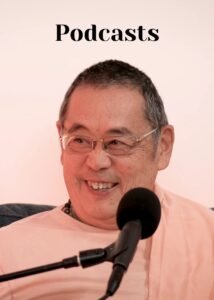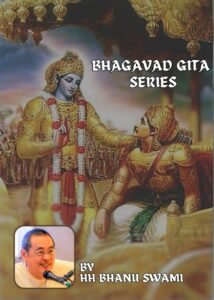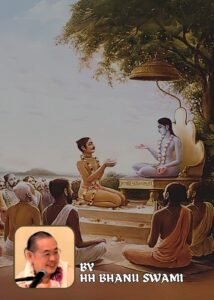SB 10.52.26~30 by HH Bhanu Swami Maharaj on Dec 4, 2024 @ ISKCON JAPAN
tad avetyāsitāpāṅgī
vaidarbhī durmanā bhṛśam
vicintyāptaṁ dvijaṁ kañcit
kṛṣṇāya prāhiṇod drutam
Translation
Dark-eyed Vaidarbhī was aware of this plan, and it deeply upset her. Analyzing the situation, she quickly sent a trustworthy brāhmaṇa to Kṛṣṇa.
Text 27
dvārakāṁ sa samabhyetya
pratīhāraiḥ praveśitaḥ
apaśyad ādyaṁ puruṣam
āsīnaṁ kāñcanāsane
Translation
Upon reaching Dvārakā, the brāhmaṇa was brought inside by the gatekeepers and saw the primeval Personality of Godhead sitting on a golden throne.
Text 28
dṛṣṭvā brahmaṇya-devas tam
avaruhya nijāsanāt
upaveśyārhayāṁ cakre
yathātmānaṁ divaukasaḥ
Translation
Seeing the brāhmaṇa, Śrī Kṛṣṇa, Lord of the brāhmaṇas, came down from His throne and seated him. Then the Lord worshiped him just as He Himself is worshiped by the demigods.
Text 29
taṁ bhuktavantaṁ viśrāntam
upagamya satāṁ gatiḥ
pāṇinābhimṛśan pādāv
avyagras tam apṛcchata
Translation
After the brāhmaṇa had eaten and rested, Śrī Kṛṣṇa, the goal of saintly devotees, came forward, and while massaging the brāhmaṇa’s feet with His own hands, He patiently questioned him as follows.
Text 30
kaccid dvija-vara-śreṣṭha
dharmas te vṛddha-sammataḥ
vartate nāti-kṛcchreṇa
santuṣṭa-manasaḥ sadā
Translation
[The Supreme Lord said:] O best of exalted brāhmaṇas, are your religious practices, sanctioned by senior authorities, proceeding without great difficulty? Is your mind always fully satisfied?
Purport
Here we have translated the word dharma as “religious practice,” although this does not fully convey the Sanskrit sense of the word. Kṛṣṇa did not appear within a secular society. The people in Vedic times could hardly imagine a society that did not understand the need to obey God’s law. Thus to them the word dharma conveyed a sense of duty in general, higher principles, prescribed duty and so on. It was automatically understood that such duties were within a religious context. But religion in those days was not a specific aspect or department of life, but rather a guiding light for all activities. Irreligious life was considered demoniac, and God’s hand was seen in everything.
HH Bhanu Swami Maharaj :
Now, Rukmini sent this trusted brahmana to give a message to Krishna. Why? Because she was very depressed when she heard that her brother wanted to get her married to Sishupala. Though she had not met Krishna, still she was bold enough to write him a letter. And she carried the message through a trusted brahmana. And the brahmana went there and was worshipped by Krishna. And then Krishna begins to inquire from him.
And if we look in Bhagavatam, we’ll find this is often the procedure. You welcome the guests, in particular the brahmana, then you say, How are you? Are you fine? etc.
And in that society, this was important. The brahmana should be happy. Though the Kshatriyas rule the country, the topmost person is the brahmana. And thus, even the king worships the brahmana. This seems a little bit strange for our modern thought.
And the person on top is the leader of the country, everybody worships him. He doesn’t worship anybody. So there was a difference. The difference was that the leaders, the Kshatriyas, had different qualities. Normally, we think of a leader as being very passionate.
And that is manifested by his quality of liking to control. And also by his ability to fight. Unless you’ve got Rajoguna, you’re not going to fight.
However, we see in the Vedic system that the Kshatriya was a combination of Rajoguna and Sattvaguna. And thus we’ll see in the Bhagavatam. We have Kshatriyas like Bhismadeva, and he will be giving discourses on Dharma. So this means that they also are very knowledgeable of scripture. And they give respect to the Brahmanas.
So that can take place if they have some sattva in their nature. If they’re pure in Rajoguna, they will not respect anybody. Or if they do respect the Brahmana, it is only to get something out of the Brahmana. So Ravana may have lots of praising Brahmanas doing sacrifices for him so he can get more money and power.
So the real Kshatriya, because he has a little bit of sattva in him, supports the Brahminical community. He understands that to rule as a Kshatriya properly, he needs the guidance of the Brahmanas. So the ideal Kshatriya is not just a ruler, but he’s a philosopher, and he’s very conversant with Dharma, and he understands that the goal is not to simply enjoy in this world, but to get out of the material world. And liberation, getting out of the material world is the goal.
So the demoniac leaders may give respect to the Brahmana, because they will get punya, by punya they can continue their power. So the Brahmana should be respected, but the best is to respect him for the proper reasons.
So here Krishna asks the Brahmanas, are you satisfied? So what will satisfy a Brahmana? How will he be satisfied? So the real Brahmana does not want money, does not want material things. We see that Ramachandra gave all the kingdom to the Brahmanas, the Brahmanas gave it back, they don’t want it. So they are satisfied with very little. But they don’t want their practices interrupted. So Krishna asked here that “Is your Dharma being preserved properly.”
There should be no obstacles to his practices. So whatever is necessary for living, yes, that should be there, and there should be no disturbances from other people, and with whatever little he needs, that should be supplied.
We see when Balarama was travelling around, he met the sages and then the sages said, well, the only thing we want is to stop this demon from disturbing our sacrifice. So when the Brahmana community is supported nicely and they live peacefully, they do their job, they study the vedas, they get knowledge, they can advise the king properly. So that is the ideal system, and Krishna also practices this to inspire people.
Of course, this word Dharma also has a little bit unclear meaning. It becomes unclear because as Vaishnavas, we sometimes reject Dharma “Sarva Dharman Paritajya”. So Krishna is upholding Dharma, teaching Dharma, Bhisma is speaking about Dharma, etc. And then Krishna comes along and says, reject all Dharma, just worship me. So the meaning of this is that Dharma is important in general for maintaining society.
But more important than Dharma is Bhakti. So that’s why Krishna says, forget about all Dharma, just worship me. So if there is a choice, you do Dharma or you do Bhakti, we must choose Bhakti. So in any case we should do the Bhakti. But we can do both together.
If we do Dharma without Bhakti this becomes asuric varnashram. We speak of Daiva varnasrama, so the opposite is asuric varnashrama. So it may look like Dharma, all the rules are the same, etc., but don’t worship Krishna.
So when Duryodhana ruled in place of the Pandavas or whatever, he ruled like a Kshatriya, and in one sense it looked very nice. He was following all the rules of Kshatriya.
So what’s wrong? He’s a good king. So the problem is, he rejected Krishna completely.
So he may give an appearance of Dharma, but it’s not real Dharma.
So to really make that dharma permanent you also have to include bhakti. So these great kings like Jarasandha or Duryodhana or Ravana it looks like they’re doing dharma also and people may say well what’s wrong with it but no bhakti therefore ultimately it’s a temporary show only.
So an intelligent person will understand that dharma is also dependent on bhakti. So that type of dharma we do not reject. Still, even that dharma we should distinguish from bhakti itself. So within the varnashrama system we should have bhakti and worship the Lord but to perform bhakti as a separate item and a main item that is much more powerful. That is because the goals of these systems are different.
The goal of dharma is stable, happy, material, sattvic life. And by also doing bhakti we can get that material benefit. The goal of bhakti is prema, nothing to do with the material world at all. So the goals are different. So that’s why again we say reject dharma, just do bhakti because we want to emphasize that the goal is different. The goal is prema, not the material world.
So Krishna performs varnashramic duties as a great king etc. at the same time he’s teaching that the highest principle is bhakti.
Hare Krishna.
Q & A:
1) In Srimad Bhagavatam, we see that, “savai pumsam paro dharmo, etho bhaktir adhoksaje, ahaithuki aprathihati, yayatma suprasaidati”, so as I mentioned, our paro dharma, our supreme occupation, is to attain devotional service to Krishna, but at the current condition, I have my family and children, so I have to do some material work. So, in that case, how do I define my work career, Maharaj? I mean, should I retire early that, when I think that I have enough money and I should retire? Because I think it is not “ahaithuki, apratihati”. So, could you kindly comment on that?
So, of course, Krishna is satisfied with everything. If you do dharma, he is satisfied. If you do bhakti, he is also satisfied, but he is more satisfied. But, in doing bhakti, we have a material body, and we support the material body. If you are qualified, you can renounce everything and minimize your support for your material body.
Most people are not qualified for that, so therefore bhakti allows people to support their material body more, their family, etc. So, whether you are a sannyasi or grihastha, it doesn’t matter, you practice bhakti. So, the position as in varna or ashrama is all external, and Krishna is not so attached to that. So, if one is a sannyasi devotee, ok, if one is a grihastha devotee, ok, Krishna does not prefer one or the other, they are all nice. But, He surrenders more to that devotee, who has more bhakti.
So, our goal is that bhakti, not so much the ashrama. So, it is possible to advance in any condition of life, any ashrama, any varna or whatever.
2) You mentioned about Bhishmadev. So, you know that Bishmadeva was in Virya ras, and my confusion is Bishmadeva’s Ishta devata was Narayana or Vishnu, not Krishna. So, I am wondering, Bishmadeva was a pure devotee of Krishna, but his Ishta-devata was not Krishna, and we know there is some dispute that Krishna is supreme or Vishnu is supreme. So, how do you understand the supreme position of Krishna over Vishnu or Narayana, provided that Bishmadeva’s Ishta devata is Narayana or Vishnu?
So, of course, we also see in Nandagram, Nanda Maharaj has a deity of Vishnu, as his Ishta-dev. So, even if we have devotees of Krishna, by tradition, they may be worshipping Vishnu or some other form or whatever, but ultimately, their object of surrender is Krishna.
3) What about Maharaj that you mentioned, Brahmana should not disturb their own practice more than others? But devotees are different – Brahmana, Kshatriya, Vaishya, Shudra, etc. Like, we have a temple, the management, management, disturbs the practice ?
HH Bhanu Swami Maharaj : It depends. depends on, if you’re a Brahmana Vaishnava or a Kshatriya Vaishnava, or a Vaishya Vaishnava. A Kshatriya Vaishnava Vaishnava.
Devotee: But anyway, I am a Shudra. Melacha, Yavana, anyway. But devotee, doing some seva. For some devotees, you know management, very disturbs?
HH Bhanu Swami Maharaj: Yeah. Yeah. So anyway, we try to engage in devotional service and we try to get good results. If we can’t do good results in one area, we try something else.
Devotee: Even they disturb our practice ?
HH Bhanu Swami Maharaj: Well, if we can’t do it, it disturbs us, then we do something else, which is more peaceful for us.
In the Nectar of Devotion, in the Angas of Bhakti, in the second group of ten Angas, the do not – don’t do this, don’t do that, one of that is – don’t involve in big projects. Another is, don’t make many disciples. So the purport, the meaning of this is that, if these become disturbing to your Bhakti, then we don’t want to do that.
Nevertheless, our commentators on those principles, say that well, if nobody initiates anybody, no Sampradaya. So as much as we want to increase Bhakti, etc., and preach, fine, we do that. So we do whatever we can, in preaching, plus we have to maintain our own spiritual life. So our contribution to preaching may also be in various ways, according to our abilities. And if we can do that, then that’s where we’ll be most productive, we’ll get the most results.
4) Maharaj, to the point of satisfaction, as a Vaishnava, we always say like, I want to do preaching, I want to use everything for Krishna as per yukta vairagya concept, then I want more. If I have more money, then I can do more, like that. But we can get attached to all these, so how these yukta vairagya be helpful ?
HH Bhanu Swami Maharaj: Got the question ?
Translator : No
HH Bhanu Swami Maharaj : How do we practice Yukta Vairagya? Because we want to use everything for Krishna, but then we want to get more. So we can use more, so we endeavour to get more things. So how do we balance?
So like I said, don’t have big projects, don’t have many disciples, don’t study too many scriptures are there. Because we can’t over burden and emphasize too much results in one area and sacrifice our spiritual life. So we can’t disturb our spiritual life too much to get all these goals.
There is one Anartha in Bhakti mentioned in Madhura Kadambini, that Anartha is, the Anartha that arises from Bhakti. So that looks contradictory, because Bhakti destroys Anartha, but how could Bhakti produce Anartha? So, not due to karma, but due to bhakti, we engage in projects and we get so many things. But when we get attached to those things, that becomes an anartha.
5) Varnashrama is very complicated, very advanced, and since in modern age, it’s not a realistic / practical idea. Of course, Bhagavad Gita teaches Varnashrama, because that time, before Kali Yuga, Arjuna time, Prabhupada in purport mentioned – why Krishna introduced this time the advanced dharma. The other time like Buddha, very simple dharma[he taught]. But at that time, Arjuna and others were very civilized, advanced people. That’s why Krishna taught Varnashrama. But that is there before Kali Yuga.
Now we are at a totally different age. That’s why Chaitanya Mahaprabhu came. Then he re-established the dharma. Then again Prabhupada came and spread Chaitanya teaching / dharma. Then sometimes we think, then why is it necessary to study such a complicated dharma? Everything is cut out, only teaching – Chaitanya, Yuga dharma, Sankirtana dharma, very simple. Like Honen and Kuya, they preach only just chanting the name of Amida. So people are easy to follow. Why are we very conflicted?
HH Bhanu Swami Maharaj: Well, we take the end of Bhagavad Gita “Sarvadharman Paritajya Mam ekam Saranam vraja”. Krishna also gives that as the final instruction. Not practical to do the other dharmas in Kali Yuga, just do bhakti.
Devotee: Then, why did Krishna introduce the Varanasma dharma? He also said it’s better to teach just bhakti. Why not?
HH Bhanu Swami Maharaj: Yeah, well that’s what he says. That’s the conclusion of Bhagavad Gita. But these are there as tradition in the Vedas. So he gives chapter 3 for that or whatever. And in Bhagavatam, Kapila’s teachings and 11th canto teachings to Uddhava, Varanasma was there. But he also teaches Jnana, he also teaches Ashtanga Yoga, and he also teaches bhakti. So because they are part of the whole system, he teaches everything. But the goal ultimately is bhakti. So we shouldn’t get attached to these things, but just understand they’re part of the Vedic system.
Devotee: This way he glorified how bhakti is great, how bhakti is superior more than Ashtanga, Jnana ?
HH Bhanu Swami Maharaj: Independent and everything else is depended on it.
That’s the idea. So therefore, if you don’t do anything else, do bhakti and you’re still successful.
Devotee: He used Varanasma for the superiority of bhakti ?
HH Bhanu Swami Maharaj: Yeah.
Devotee: Thank you.
Devotees: Grantharaj Srimad Bhagavatam Ki.. Jai ! Srila Prabhupad Ki.. Jai !!


